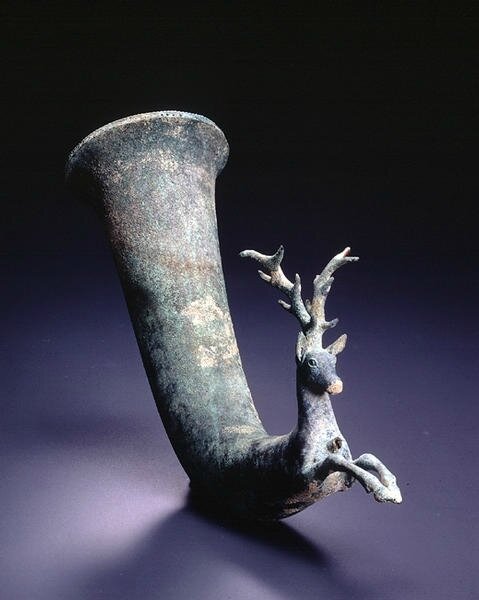Late Classical Greek Bronze Rhyton with a Stag Protome, Late Classical, ca. 4th century B.C.E., Asia Minor-Black Sea Region
Late Classical Greek Bronze Rhyton with a Stag Protome, Late Classical, ca. 4th century B.C.E., Asia Minor-Black Sea Region. Bronze, H. 37 cm. © Miho Museum
This rhyton is an example of a special type of vessel that was used by the Greeks for religious rituals. The word rhyton derives from the Greek verb "to pour through," which accurately describes what happens when liquid is added to the rhyton's flared mouth, since it immediately passes through the vessel and streams out through the open spout on the other end.
This slender horn tapers from a circular mouth with an everted lip to the exquisitely sculptured rendition of the protome (forepart) of a bounding stag. The rim of the mouth is beaded and the lip is encircled by a band of pierced ovolos. The stag was rendered in the naturalistic style that was prevalent during the Classical period (480-336 B.C.). The animal's head is drawn back on its long neck, its ears perked upright. The eyes, bordered by raised lids and topped by finely incised brows, look to the right. The upper lip of the closed muzzle extends over the lower, from which it is separated by lips with down-turned corners. A fine V is incised above the nostrils. A magnificent rack of antlers rises from a single trunk on top of the stag's head before separating into two branches of thick horns. A short, round spout emerges from the stag's chest, just above its extended front legs, which end in delicate, cloven hooves.

/https%3A%2F%2Fprofilepics.canalblog.com%2Fprofilepics%2F1%2F0%2F100183.jpg)
/https%3A%2F%2Fstorage.canalblog.com%2F03%2F02%2F119589%2F96711876_o.jpg)
/https%3A%2F%2Fstorage.canalblog.com%2F11%2F31%2F119589%2F94773502_o.jpg)
/https%3A%2F%2Fstorage.canalblog.com%2F20%2F83%2F119589%2F94772815_o.jpg)
/https%3A%2F%2Fstorage.canalblog.com%2F26%2F72%2F119589%2F75604929_o.jpg)
/https%3A%2F%2Fstorage.canalblog.com%2F59%2F60%2F119589%2F26458628_o.jpg)



/image%2F1371349%2F20240406%2Fob_b23648_434058570-1644317966338216-88086167391.jpg)
/image%2F1371349%2F20240403%2Fob_6d5ae7_dp-28103-001.jpg)
/image%2F1371349%2F20240229%2Fob_8f31f9_431013694-1625286614908018-33034430839.jpg)
/http%3A%2F%2Fstorage.canalblog.com%2F79%2F20%2F119589%2F129837997_o.jpg)